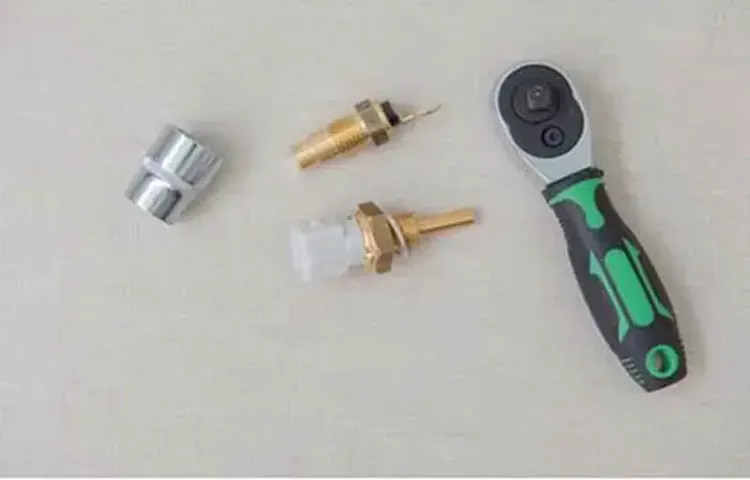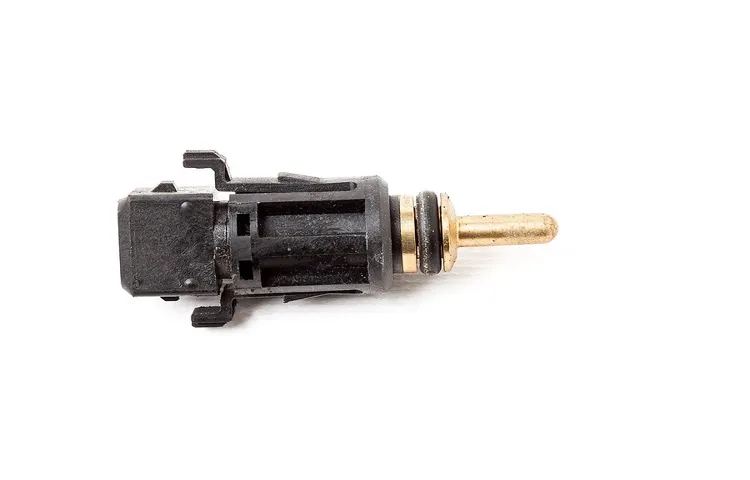Have you ever wondered how your car’s engine stays at the right temperature, even when it’s working hard? That’s where the engine coolant temperature sensor comes in. This little device plays a crucial role in keeping your engine running smoothly and preventing it from overheating. Think of the engine coolant temperature sensor as the thermostat for your car’s engine.
Just like the thermostat in your home, it monitors the temperature and signals the engine control unit (ECU) when things get too hot or too cold. This information allows the ECU to make adjustments to maintain the optimal temperature for your engine’s performance. But why is the engine temperature so important? Well, if the engine gets too hot, it can cause serious damage to components like the cylinder head, pistons, and gaskets.
On the other hand, if the engine is too cold, it may not run efficiently, resulting in decreased fuel economy and increased emissions. That’s why it’s crucial for the engine coolant temperature sensor to accurately measure the temperature and alert the ECU when adjustments need to be made. So, how does the engine coolant temperature sensor work? It’s usually located near the engine’s thermostat housing or on the radiator.
It contains a thermistor, a device that changes its electrical resistance based on temperature. As the engine warms up, the resistance of the thermistor decreases, and vice versa. This change in resistance is then converted into a voltage signal, which is sent to the ECU.
The ECU uses this information along with other data, such as the engine load and RPM, to calculate the correct fuel injection and ignition timing. It can also activate the engine cooling fan when needed to help regulate the temperature. All of these adjustments work together to keep your engine running at its best and prevent any potential damage caused by overheating.
In conclusion, the engine coolant temperature sensor is a vital component of your car’s engine management system. It ensures that your engine stays at the right temperature, allowing it to run efficiently and avoid overheating. So, the next time you start your car and see the temperature gauge rise, remember the important role that the engine coolant temperature sensor plays in keeping your engine cool and running smoothly.
Table of Contents
What is an Engine Coolant Temperature Sensor?
Are you wondering how much an engine coolant temperature sensor will set you back? Well, the price can vary depending on several factors, such as the make and model of your vehicle and where you purchase the sensor from. On average, you can expect to spend anywhere from $20 to $100 for a new sensor. However, keep in mind that labor costs for installation may also come into play if you’re not comfortable replacing it yourself.
But why is this sensor so important? Think of it as the thermostat for your car’s engine. It monitors the temperature of the coolant and sends that information to the engine control unit (ECU). This allows the ECU to adjust the fuel mixture and timing accordingly, ensuring optimal performance and fuel efficiency.
So, while the engine coolant temperature sensor may be a small part, its role in keeping your engine running smoothly is certainly a big one.
Definition
Engine Coolant Temperature Sensor An engine coolant temperature sensor is a vital component of a vehicle’s engine control system. It is responsible for measuring the temperature of the engine coolant, which is crucial for the proper functioning and performance of the engine. The sensor works by sending electrical signals to the engine control unit (ECU) to help optimize fuel injection, ignition timing, and emissions control.
Think of the engine coolant temperature sensor as the “thermometer” of your car’s engine. Just like how a thermometer measures your body temperature, the sensor measures the temperature of the engine coolant. The ECU uses this information to make adjustments to the engine’s operation, ensuring that it runs at the optimal temperature for the best performance and efficiency.
Maintaining the right temperature is essential for a vehicle’s engine. If the engine gets too hot, it can lead to overheating, which can cause severe damage. Similarly, if the engine is too cold, it may not operate efficiently and may emit more pollutants.
The engine coolant temperature sensor helps to prevent these issues by providing real-time temperature readings to the ECU, enabling it to make the necessary adjustments to keep the engine running smoothly. In addition to regulating the engine’s temperature, the engine coolant temperature sensor also plays a role in the vehicle’s onboard diagnostics system. It can detect any potential faults related to the engine’s temperature, such as a malfunctioning thermostat or a cooling system leak.
By alerting the driver or the ECU to these issues, the sensor helps to prevent further damage and costly repairs. In conclusion, an engine coolant temperature sensor is a crucial component of a vehicle’s engine control system. It measures the temperature of the engine coolant and helps the ECU optimize engine performance and efficiency.
By ensuring that the engine runs at the right temperature, the sensor plays a vital role in preventing overheating and maintaining the overall health of the engine. So, the next time you start your car, remember that there’s a little sensor working behind the scenes to keep your engine running smoothly.

Function
engine coolant temperature sensor
Location
location, engine coolant temperature sensor, purpose, functionality, signs of a faulty sensor The engine coolant temperature sensor, also known as the ECT sensor, is a crucial component in a vehicle’s engine system. Its main purpose is to monitor and regulate the temperature of the engine coolant. This sensor is typically located in or near the engine’s coolant system, such as on the engine block or cylinder head.
The ECT sensor plays a vital role in maintaining the engine’s temperature within a certain range. It provides important data to the engine control unit (ECU), allowing it to adjust fuel delivery and ignition timing to optimize performance and fuel efficiency. This sensor also helps prevent overheating by triggering warning lights or engine shutdown if the coolant temperature gets too high.
A faulty ECT sensor can lead to various problems and even engine damage if not addressed. Common signs of a faulty sensor include inaccurate temperature readings, engine misfires, poor fuel economy, and even engine stalling. If you notice any of these symptoms, it is crucial to have the sensor checked and replaced if necessary.
Overall, the engine coolant temperature sensor is a small yet crucial component in a vehicle’s engine system. Its location and functionality are essential for maintaining optimal engine performance and preventing overheating. Regular maintenance and timely replacement of a faulty sensor can help ensure the smooth operation of your vehicle’s engine.
Importance
engine coolant temperature sensor
Signs of a Failing Engine Coolant Temperature Sensor
If you’re wondering how much an engine coolant temperature sensor costs, the price can vary depending on the make and model of your vehicle. On average, you can expect to pay anywhere from $20 to $100 for a new sensor. However, keep in mind that this is just the cost of the part itself and does not include any labor costs for installation.
It’s always a good idea to consult with a professional mechanic to get an accurate estimate for your specific vehicle. Now, let’s talk about the signs of a failing engine coolant temperature sensor. One common symptom is an overheating engine.
If the sensor is not working properly, it may not send the correct temperature readings to the engine control unit, causing it to miscalculate the fuel-to-air mixture and potentially lead to overheating. Another sign is poor fuel efficiency. If the sensor is sending incorrect readings, the engine may not be operating at the optimal temperature, leading to decreased fuel efficiency.
Additionally, you may also notice fluctuating temperature gauge readings or a check engine light illuminated on your dashboard. These are all signs that it may be time to replace your engine coolant temperature sensor.
Overheating Engine
engine coolant temperature sensor
Inaccurate Temperature Readings
engine coolant temperature sensor, failing engine coolant temperature sensor, inaccurate temperature readings, signs of a failing engine coolant temperature sensor
Check Engine Light
engine coolant temperature sensor, check engine light, signs of failure The check engine light in your car can be a source of anxiety and confusion. It could mean anything from a loose gas cap to a major engine problem. One possible culprit for your check engine light turning on is a failing engine coolant temperature sensor.
This small but essential part monitors the temperature of your engine coolant and sends that information to the engine control module. When the sensor starts to fail, it can give inaccurate readings or fail to send any information at all. This can lead to a variety of issues, such as poor fuel economy, difficulty starting your car, or even engine overheating.
So, how can you tell if your engine coolant temperature sensor is failing? Well, there are a few signs to watch out for. One common sign is a constantly fluctuating temperature gauge. If your temperature gauge is bouncing around, it could be a sign that the sensor is sending inconsistent readings to the engine control module.
Another sign is if your check engine light constantly turns on and off. While this could indicate other issues, a failing engine coolant temperature sensor is definitely one possibility. Lastly, if your car is having difficulty starting, especially in cold weather, it could be because the engine coolant temperature sensor is not sending the correct information to the engine control module.
If you notice any of these signs, it’s important to have your car checked by a professional mechanic. They can diagnose the issue and replace the engine coolant temperature sensor if necessary. By addressing the problem early, you can prevent further damage to your engine and avoid costly repairs down the line.
So, don’t ignore that pesky check engine light. It could be trying to tell you that your engine coolant temperature sensor needs attention.
Poor Fuel Efficiency
Poor Fuel Efficiency One of the signs that your engine coolant temperature sensor may be failing is poor fuel efficiency. This is because the engine coolant temperature sensor plays a vital role in regulating the engine’s temperature. When the sensor is not functioning properly, it may send incorrect signals to the engine control unit (ECU) about the temperature of the coolant.
This can result in the engine running too hot or too cold, causing the fuel mixture to be less efficient. As a result, your car may consume more fuel than necessary, leading to poor fuel efficiency. It’s like trying to cook a meal with a faulty thermostat on your stove – you won’t be able to maintain the right temperature and your food might not cook evenly.
Similarly, a failing engine coolant temperature sensor can throw off the delicate balance of fuel and air in your engine, causing it to work harder and use more fuel. So, if you’re noticing that you’re getting fewer miles per gallon than usual, it might be worth getting your engine coolant temperature sensor checked out.
How Much Does an Engine Coolant Temperature Sensor Cost?
If you’re experiencing issues with your engine’s temperature, it’s possible that your engine coolant temperature sensor may need to be replaced. But how much does an engine coolant temperature sensor actually cost? Well, the price can vary depending on the make and model of your vehicle, as well as where you purchase the part from. On average, you can expect to spend anywhere from $20 to $100 for a new engine coolant temperature sensor.
However, keep in mind that this is just the cost of the sensor itself, and doesn’t include any additional fees for installation or labor. It’s always a good idea to consult with a professional mechanic or automotive specialist to get an accurate estimate for your specific vehicle.
Factors That Affect Cost
engine coolant temperature sensor cost
Average Price Range
engine coolant temperature sensor cost The average price range for an engine coolant temperature sensor can vary depending on several factors such as the make and model of the vehicle, the brand of the sensor, and where it is purchased. On average, you can expect to pay anywhere from $20 to $100 for a new engine coolant temperature sensor. However, it is important to keep in mind that these prices can fluctuate and may also include additional costs such as labor fees if you choose to have the sensor installed by a professional.
It’s always a good idea to shop around and compare prices from different retailers or mechanics to ensure you are getting the best deal.
Additional Costs to Consider
engine coolant temperature sensor cost
How to Replace an Engine Coolant Temperature Sensor
Replacing an engine coolant temperature sensor is a relatively straightforward task that can be done by a car owner with basic mechanical skills. However, the cost of the sensor itself can vary depending on the make and model of the car. On average, the price of an engine coolant temperature sensor ranges from $20 to $100.
It’s always a good idea to check with your local auto parts store or online retailers to get an accurate price for your specific car. Replacing the sensor involves locating the old sensor, disconnecting the electrical connector, and removing the sensor from its housing. Once the old sensor is removed, the new sensor can be installed by reversing the steps.
It’s important to note that before replacing the sensor, it’s recommended to drain the coolant to prevent any spills or accidents. Overall, replacing an engine coolant temperature sensor is a cost-effective way to ensure your engine is running at the optimal temperature and prevent any potential overheating issues.
Step 1: Gather the necessary tools and equipment
Replacing an engine coolant temperature sensor is a relatively straightforward task that can be done by most car owners with a bit of mechanical know-how. The first step in the process is to gather all the necessary tools and equipment. You will need a set of wrenches or sockets, depending on the type of sensor and its location in the engine bay.
It’s also a good idea to have a drain pan or bucket to catch any coolant that may leak out during the process. Additionally, having a rag or towel on hand to wipe up any spills or drips is always helpful. Once you have all of these items, you are ready to move on to the next step in the process.
Step 2: Locate the sensor
engine coolant temperature sensor
Step 3: Disconnect the electrical connector
Replacing the engine coolant temperature sensor is a straightforward task that requires a few simple steps. In this article, we will focus on step three: disconnecting the electrical connector. Now, before we dive into the nitty-gritty details, let me ask you this: have you ever tried to unplug a stubborn electrical wire? It can be quite a challenge, right? Well, disconnecting the electrical connector of the engine coolant temperature sensor is no different.
You might encounter a bit of resistance, but with a steady hand and a gentle tug, you’ll be able to detach the connector without any issues. Just remember to handle the connector with care and avoid pulling on the wires themselves. Once you’ve successfully disconnected the electrical connector, you can move on to the next step in replacing the engine coolant temperature sensor.
Stay tuned for more tips and tricks on how to successfully complete this task!
Step 4: Remove the old sensor
Replacing an engine coolant temperature sensor is typically a simple task that can be done on your own with just a few tools. Once you’ve identified the faulty sensor and have purchased a new one, it’s time to remove the old sensor. This step is crucial in ensuring that the new sensor can be installed properly and function correctly.
To start, locate the old sensor, which is usually located near the engine cylinder head or in the intake manifold. Use a wrench or socket set to loosen and remove the sensor, taking care not to damage the surrounding components. It may be helpful to refer to your vehicle’s service manual, as the exact location and removal process may vary depending on the make and model of your car.
Once the old sensor is removed, inspect it for any signs of damage or corrosion. If necessary, clean the area where the sensor was installed before proceeding to the next step. With the old sensor removed, you’re now ready to install the new one.
Step 5: Install the new sensor
In order to replace an engine coolant temperature sensor, you will first need to install the new sensor. This step is crucial in ensuring that your vehicle’s engine is properly monitored and can prevent any potential overheating issues. To begin, locate the sensor on your engine.
It is typically located near the thermostat housing or on the cylinder head. Once you have found the old sensor, disconnect the electrical connector by gently squeezing the tabs and pulling it off. Next, use a wrench or socket to carefully remove the old sensor from its mounting location.
Be cautious not to damage any surrounding components. With the old sensor removed, take your new sensor and apply a small amount of thread sealant to the threads. This will help create a leak-proof seal.
Carefully thread the new sensor into place by hand, ensuring that it is tight but not over-torqued. Finally, reconnect the electrical connector and double-check that everything is secure. Once the new sensor is installed, you can move on to the next step of the process.
Step 6: Reconnect the electrical connector
In the final step of replacing an engine coolant temperature sensor, you will need to reconnect the electrical connector. This step is important because it ensures that the sensor will be able to communicate with the vehicle’s computer system. To reconnect the connector, you will need to align the pins on the sensor with the slots in the connector and then firmly push them together until you hear a click.
It’s important to make sure that the connector is fully seated and secured, as a loose connection can lead to inaccurate temperature readings and potential engine problems. Once the connector is securely attached, you can move on to the next step and complete the installation of the new sensor. By following these steps and properly reconnecting the electrical connector, you can ensure that your engine’s coolant temperature sensor is installed correctly and functioning properly.
Step 7: Test the new sensor
engine coolant temperature sensor
Conclusion
So, how much is a engine coolant temperature sensor? Well, it’s not just a simple question of dollars and cents. You see, the engine coolant temperature sensor is not just a little piece of metal or plastic that you can pick up at your local auto parts store for a few bucks. Oh no, my friend, it is so much more than that.
This tiny sensor plays a crucial role in the proper functioning of your vehicle’s engine. It constantly monitors the temperature of the coolant and sends this information to the engine computer, which then adjusts various parameters to ensure optimal performance and fuel efficiency. In other words, it’s kind of a big deal.
Now, you may be wondering, how much is something so important and integral to the well-being of your car? Well, it really depends on a variety of factors. The make and model of your vehicle, the brand of the sensor, and where you purchase it from can all have an impact on the price. On average, you can expect to pay anywhere from $20 to $100 for a quality engine coolant temperature sensor.
But hey, can you really put a price tag on peace of mind and a well-running engine? So, the next time someone asks you how much is a engine coolant temperature sensor, you can impress them with your newfound knowledge. And maybe even throw in a little joke for good measure, like “Well, it’s not cheap, but hey, neither is a broken-down car on the side of the road!” Remember, my friends, investing in the proper maintenance and care of your vehicle is always money well-spent. And when it comes to something as important as the engine coolant temperature sensor, it’s definitely worth every penny.
FAQs
What is an engine coolant temperature sensor?
An engine coolant temperature sensor is a device that monitors the temperature of the engine coolant and sends this information to the engine control unit (ECU) to ensure optimal engine performance.
Why is the engine coolant temperature sensor important?
The engine coolant temperature sensor is important because it allows the ECU to adjust the fuel mixture and ignition timing based on the engine’s operating temperature. This helps to ensure efficient combustion and optimal engine performance.
How does the engine coolant temperature sensor work?
The engine coolant temperature sensor typically uses a thermistor, which is a type of electrical resistor that changes its resistance based on temperature. The sensor is mounted in the engine block or cylinder head and measures the temperature of the coolant. The resistance value of the thermistor is then converted into an electrical signal that is sent to the ECU.
What are the signs of a faulty engine coolant temperature sensor?
Some common signs of a faulty engine coolant temperature sensor include erratic engine temperature readings, engine misfires, poor fuel efficiency, and a Check Engine light illuminating on the dashboard. It is important to address these issues promptly, as a faulty sensor can negatively affect engine performance and potentially cause engine damage.
How much does a new engine coolant temperature sensor cost?
The cost of a new engine coolant temperature sensor can vary depending on the make and model of the vehicle. On average, the sensor itself can range from $20 to $100. However, additional costs such as labor fees for installation may apply if you choose to have a professional mechanic replace the sensor.
Can I replace the engine coolant temperature sensor myself?
It is possible to replace the engine coolant temperature sensor yourself if you have the necessary tools and knowledge. However, it is important to note that working with the electrical system of a vehicle can be complex, and if not done correctly, it can cause further damage. If you are unsure or uncomfortable with the process, it is recommended to seek the assistance of a professional mechanic.
How often should the engine coolant temperature sensor be replaced?
The engine coolant temperature sensor is not a typical maintenance item that needs to be replaced regularly. However, like any electrical component, it can fail over time. If you are experiencing issues with your engine’s temperature readings or suspect a malfunctioning sensor, it is best to consult your vehicle’s manufacturer guidelines or a professional mechanic for advice.



